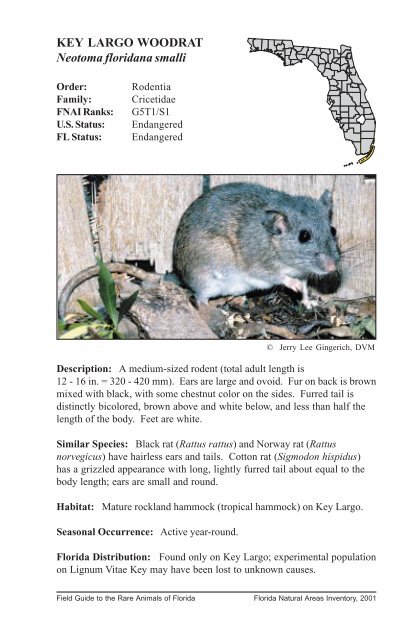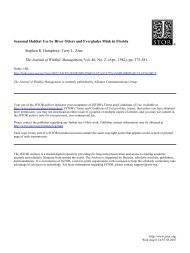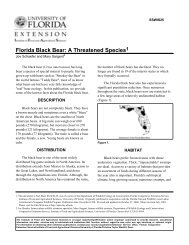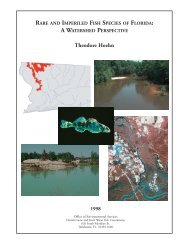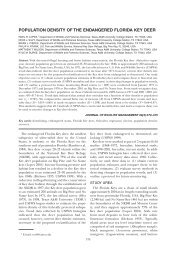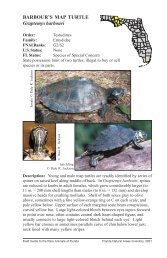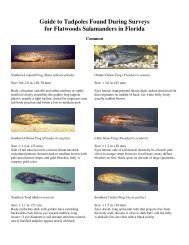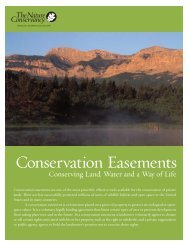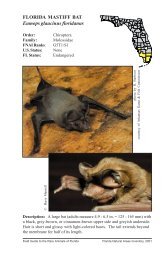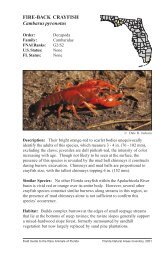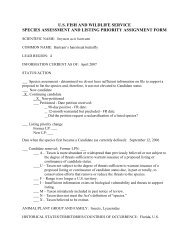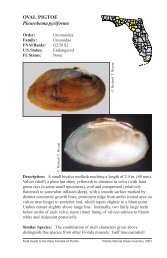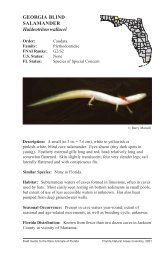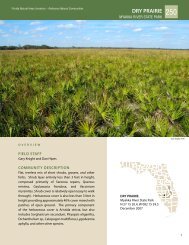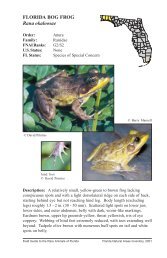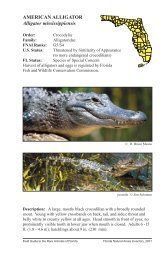KEY LARGO WOODRAT Neotoma floridana smalli - Florida Natural ...
KEY LARGO WOODRAT Neotoma floridana smalli - Florida Natural ...
KEY LARGO WOODRAT Neotoma floridana smalli - Florida Natural ...
Create successful ePaper yourself
Turn your PDF publications into a flip-book with our unique Google optimized e-Paper software.
<strong>KEY</strong> <strong>LARGO</strong> <strong>WOODRAT</strong><br />
<strong>Neotoma</strong> <strong>floridana</strong> <strong>smalli</strong><br />
Order:<br />
Family:<br />
FNAI Ranks:<br />
U.S. Status:<br />
FL Status:<br />
Rodentia<br />
Cricetidae<br />
G5T1/S1<br />
Endangered<br />
Endangered<br />
Description: A medium-sized rodent (total adult length is<br />
12 - 16 in. = 320 - 420 mm). Ears are large and ovoid. Fur on back is brown<br />
mixed with black, with some chestnut color on the sides. Furred tail is<br />
distinctly bicolored, brown above and white below, and less than half the<br />
length of the body. Feet are white.<br />
Similar Species: Black rat (Rattus rattus) and Norway rat (Rattus<br />
norvegicus) have hairless ears and tails. Cotton rat (Sigmodon hispidus)<br />
has a grizzled appearance with long, lightly furred tail about equal to the<br />
body length; ears are small and round.<br />
Habitat: Mature rockland hammock (tropical hammock) on Key Largo.<br />
Seasonal Occurrence: Active year-round.<br />
© Jerry Lee Gingerich, DVM<br />
<strong>Florida</strong> Distribution: Found only on Key Largo; experimental population<br />
on Lignum Vitae Key may have been lost to unknown causes.<br />
Field Guide to the Rare Animals of <strong>Florida</strong> <strong>Florida</strong> <strong>Natural</strong> Areas Inventory, 2001
<strong>KEY</strong> <strong>LARGO</strong> <strong>WOODRAT</strong><br />
<strong>Neotoma</strong> <strong>floridana</strong> <strong>smalli</strong><br />
Range-wide Distribution: Same as <strong>Florida</strong> distribution. Other subspecies<br />
occur from south-central <strong>Florida</strong> throughout much of the eastern and<br />
south-central U.S.<br />
Conservation Status: Protected on Key Largo Hammock State Botanical<br />
Site; areas protected on Key Largo and adjacent islands (as of 2001) may<br />
not be sufficient for the long-term survival of this subspecies.<br />
Protection and Management: Prevent cutting of tropical hammock.<br />
Preserve additional habitat. Improve suboptimal habitats by depositing<br />
limerock piles. Reclaim abandoned lots.<br />
Selected References: Brown 1997, Hersh 1981, Humphrey 1988,<br />
Humphrey (ed.) 1992, Lazell 1989.<br />
nest © Barry Mansell<br />
Field Guide to the Rare Animals of <strong>Florida</strong> <strong>Florida</strong> <strong>Natural</strong> Areas Inventory, 2001


